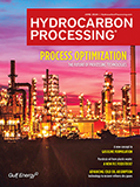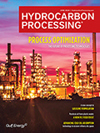2021 AFPM Annual Meeting Virtual Edition: Refinery of the future—A capital strategy to navigate changing markets
LEE NICHOLS, Editor-in-Chief/Associate Publisher, Hydrocarbon Processing
“This past year was undoubtedly the most critical and consequential year in our collective history,” said Bryan Glover, President, Honeywell UOP, setting the stage for the company’s virtual 2021 industry outlook presentation at the AFPM Annual Meeting. Due to mass gathering restrictions, Honeywell UOP converted its annual customer dinner at the AFPM Annual Meeting to a virtual address.

BRYAN GLOVER, President, Honeywell UOP
Glover’s address began with the acknowledgement of the 50th anniversary of the introduction of the CCR Platforming process, which made it economical to produce high-octane gasoline that contained no lead. The process “also revolutionized the petrochemicals industry by dramatically improving the reliability and economics of aromatics production, making it possible to produce millions of different petrochemical products in use around the world every day,” Glover said.
Following the recognition of CCR Platforming’s anniversary, Glover detailed the challenges faced over the past year due to the COVID-19 global pandemic. “We have never seen anything like it before,” he said. “Global refined fuels demand fell 9% in just one month, which was the steepest and deepest decline in our lifetimes. As a result of COVID-19, companies adopted strong defensive postures, which included halting new investments, deferring discretionary expenses, reducing workforce size, adjusting product slates to reduce losses and idling capacity—some of it permanently.”
Proceeding with caution. Although current market conditions are not back to pre-COVID levels, they are stabilizing. “New projects are coming back online again,” Glover said. “We are even beginning to see inflation in commodities related to refining and petrochemicals, which is a sign of recovery; however, it also means these additional costs must be passed through. Oil demand is forecast to gain strength through the year, but we do not believe it will reach pre-COVID levels until 2022. We expect a world GDP growth of 4% this year and that it will maintain that level for years to come.”
Despite the forecasted growth in energy demand, many producers are still cautious about building new capacity and the types of investments they are making. Transportation fuels demand is forecast to increase in developing economies but plateau or even decrease in developed ones. Coupled with transportation fuel demand dynamics, many countries around the world have instituted strict regulations on carbon emissions and fuel specifications. These macroeconomic trends have affected capital spending. “Today, refiners are investing in more efficient and environmentally sound technologies and renewable fuels as part of a low-carbon economy. However, most of the industry will maintain a conservative stance on new investments. Projects that previously were greenlighted with an 8%–10% internal rate of return (IRR), now need at least 15%–20% IRR to move forward.”
Where is the refining capacity growth heading? According to Glover, capacity growth in refining is coming from the modernization and expansion of existing complexes. These investment decisions are taking one of three routes:
- Petrochemical integration
- Renewable fuels production
- Advanced technologies to optimize production.
To maximize growth markets, refiners are investing in integrating petrochemical production units into existing refining assets.
“Refiners are integrating their core operations into petrochemicals, where long-term demand growth is stronger and margins are wider and more stable,” Glover said. “In fact, we are now designing the first refineries configured to produce only petrochemicals. Over the next 30 years, population growth and rising global GDP will drive 50% growth in petrochemicals demand, which is why the petrochemicals industry is the fastest-growing sector in the oil and gas industry, representing one-third of all capital investment today. Modern refineries are planning to achieve 50%–80% petrochemicals production without stranding existing process units. This level of integration is what we call the refinery of the future.”
With stricter environmental regulations, government policies and initiatives and shifting public attitudes, many refiners are investing in renewable fuels production. “Despite the significant drop in fuels demand last year, there was an unprecedented interest in producing diesel and jet fuel from renewable sources,” Glover said. “This provides a route for refiners to achieve their environmental goals, with minimal disruption, using the existing fuels infrastructure and the large installed base of vehicles as a ready-market for renewable fuels.”
For companies choosing to remain in crude-based fuels production, a third route of investment is through advanced technologies to produce high-quality fuels at the lowest cost, with the least amount of waste. These kinds of investments are made possible through the revolutionary molecular management made by Honeywell UOP.
Glover closed his address with remarks on the refinery of the future. “The refinery of the future is not a configuration or technology; it is a capital investment strategy—unique to each facility—that captures growth by providing the flexibility to profit from changing markets and ensure competitiveness. It anticipates changing product demand, feedstock availability, new technologies and tightening environmental regulations.”
Glover went on to explain that the refinery of the future will be a fundamental change in the manner and quality of services provided to refiners and petrochemical companies. “Refineries will be digitally connected and equipped to continuously analyze performance data to improve optimization, energy consumption and water use, while eliminating waste. This will enable plants to operate closer to peak performance capabilities, while maintaining higher onstream reliability.”






Comments